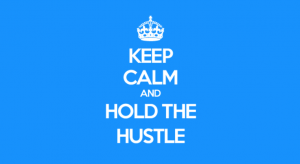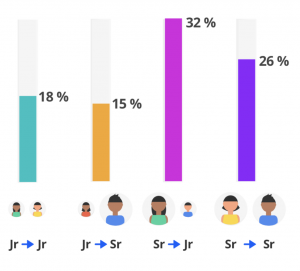The Real Key Metrics (and Magic Numbers) Behind Successful B2B Sales Outreach
The Real Key Metrics (and Magic Numbers) Behind Successful B2B Sales Outreach

As a B2B sales professional selling to other B2B sales professionals, one of my primary goals during a sales call is figuring out the organization’s pain points. Of course, this varies based on many factors: the role and level of seniority of the person I’m talking to, the size of the company, the number of direct reports, etc.
One thing every potential prospect can definitely stand to gain, though, is an objective overview of their sales funnel and more transparency on how they can improve and strengthen their relationships. There is a problem in cementing these business relationships. Every outreach effort comes at a cost: from finding and coaching the right sales reps to reaching out to the right prospects and finding them at the right time and with the right message. With so many issues coming into play, how will you gauge how well your sales team is doing compared to the rest of the industry?
Old Motto: It’s All About the Hustle
At some point five to ten years ago, “hustle” became the most valuable tool in a salesperson’s arsenal. Persistency was crucial and we all believed the more volume, the better. That is until we started automating our efforts. All of a sudden, buyers began to tune us out, and our efforts grew more and more stagnant.
If you think about it, the idea that we should increase our volume of outreach is opposed to two main forces: psychology and technology.
Sure, if you were a buyer in 2010, the chances are that an initial follow-up email actually piqued your interest — moving you to give the persistent rep 30 minutes of your time. Fast forward to 2018, and you get that email about 100 times a day. With your plate overflowing with goodies, you’re unlikely to even glance at those emails as you speed-click, “delete.”
Secondly, approaching outbound sales as purely a numbers games means going head to head with technology — namely artificial intelligence (AI). Yes, AI can certainly be your friend but think about it: every email platform today is better at identifying spam than ever before. Those countless, generic “just following up” emails? They’re getting re-routed to the spam folder with blinding quickness.
These forces also come into play beyond initial outreach. Just because you’ve gotten your foot in the door with a net new prospect, it doesn’t mean the work ends there. Building those relationships makes even more outreach necessary — both to strengthen the overall relationship and to move the deal along. But how do you compete with an increasingly disinterested party and ruthless spam folder?
New Motto: #HoldTheHustle

How do you move to the new way of doing things while effectively coaching your sales team to do better?
There’s a lot of research to support the claim that successful sales coaching programs contribute directly to revenue performance.
According to the Corporate Executive Board Company:
“Sales reps who receive just three hours of coaching a month exceed their goals by seven percent, boosting revenue by 25 percent and increasing the average close rate by 70 percent.”
Unfortunately, too many organizations aren’t dedicating the resources they should to make coaching part of company culture. When Nudge polled 100 sales leaders on their organization’s level of sales coaching maturity — more than half reported that coaching efforts were ad hoc at best.
The reality is, many sales leaders are simply tracking metrics, making their team log every call, and hoping for the best. They still view sales as a numbers game and believe that persistence is vital. But what if I told you that that wasn’t true — that there is such a thing as going too far?
Several magic numbers can act as a benchmark for better overall sales performance.
Manage What You Measure
Data is important but simply tracking it isn’t an effective use of your time — you have to manage it. Understanding which industry-standard metrics your sales reps are meeting, exceeding, or coming up short on will help you focus your coaching efforts in the right areas. You’ll want a determination of where you will focus the quality of your outreach. Will your company work toward volume, timing, or maybe titles?
Striving to help users do more effective outreach at every level of the sales cycle is where you want to land. Nudge has provided a report that shares quantitative sales benchmark information that answers key sales outreach questions.
First is the analyzation data from 3.1 million conversations between 1.4 million salespeople.
This measurement gives enough information to achieve statistical significance across eight key roles. You’ll note two levels of seniority, and 20 different industries to find the industry standard and best-in-class sales outreach metrics. There are, of course, several metrics across every stage of the sales cycle and every one of those metrics tell a different story about how you could be approaching your relationships.
Let’s focus on 4 key metrics that every sales team should be looking at:
- The number of emails needed to get a response.
- Timing between outreach efforts and response.
- Email response rates.
Focusing on these numbers will help you do outreach more effectively. These are the number that tends to be where people mess up the most.
1. Outreach Volume
It takes several minutes to craft a well-researched, personalized email. But when reaching out to a prospect multiple times, you eventually get to the point where there is little use in sending “just another follow-up.” So, what’s the sweet spot after which you should re-focus your efforts on moving on to building relationships with a new prospect (net new or otherwise)?
While the answer varies depending on a few factors (role, seniority of both parties, and industry), research has found that to get 90 percent of responses you’ll get — it takes between four to five emails.
Ultimately, a high volume of activity doesn’t correlate to more deals, so hiring more Business Development Reps (BDRs) and turning up the number of outbound activities doesn’t necessarily equate to more revenue. Using your new coaching opportunities — if you only measure the number of activities without looking at the quality of those interactions — you might be missing out on opportunities to learn from high-performing reps.
2. Response Timeline
When going after a valuable prospect, trying to get their attention for days or weeks on end may feel like it’s worth it. But just as you’re only likely to get 90 percent of your responses after four emails, there’s also a time cap after which you’re unlikely to ever get an answer. So, when is it time to move on to the next?
While the timeline varies based on the seniority of both the sales rep and the prospect, 90 percent of the responses you’re going to get will come within five weeks of your first outreach email.
This is based on the knowledge that 90 percent of outreach sequences across roles are up to 13 weeks long, with the average sequence length being just 6.5 weeks long. It’s also interesting to note that, on average, four outbound emails are sent per sequence, with 90 percent of sequences containing seven emails or less.
Why does this matter? Most sales reps continue to reach out to prospects well past the five-week period – which is when they’re the most likely to get a response. Additionally, they send up to three more emails in their outreach sequence than the recommended four.
Most sales professionals waste 1.5 weeks and three emails per outreach sequence and on prospects that are most likely not going to respond.
These numbers are based on communications found at all level of the sales cycle and serve to illustrate a point. Whether you’re dealing with net new prospects or you’re relationship building with current prospects, the struggles aren’t that much different. This makes a good case for quality over quantity.
3. Response Rate
Other than raw activity (volume), response, open, and clickthrough rates remain the most prevalent success metrics for sales reps. It’s widely accepted that these numbers tend to be quite low — especially when it comes to cold outbound emails. The success of each outreach is affected by a number of factors, ranging from the right subject line, the level of personalized content and the prospect themselves, to the number of emails sent and the length of each outreach sequence. What response rate should you be striving for in your particular role?
While reps in different vital roles have response rates that range from 12% – 22% (depending on seniority) and individual email response rates vary between three percent and six percent.
Prospects who eventually respond to sales outreach emails do so at an average rate of about 15.5 percent. If this number seems high, it’s likely because you’re only thinking of initial outreach. There won’t be sales reps out there hitting these numbers with cold outreach efforts.
How do top sales reps get high response rates? Simple: they expand their outreach beyond the initial prospect and broaden their conversations to other contacts at the company. Rather than focus on relentless cold outreach, they build relationships with existing relationships on top of the committee of others who need to opt-in in order to make that one successful sale. This will mean the concerted efforts of everyone from sales leaders and IT, all the way up to the CEO.
When digging further into response rates based on the level of seniority of both the rep and the prospect you’ll get mixed pairings as you go through the sales cycle and as you talk to more and more people.
- Junior Sales Reps reaching out to Senior Prospects could expect an average response rate of 15 percent.
- Sales Leaders reaching out to their peers could expect an average response rate of 26 percent.

What’s most interesting about these stats are that they hint at something far more important than volume and seniority levels but relationships. Your sales leaders likely have a broader perspective on the industry as well as a keener ability to map out a person’s challenges — and a potential pre-existing relationship — no matter how small.
Ultimately, a sales leader is more likely to respond to outreach from a peer he has a relationship with (or sees value in building a relationship with) rather than a junior rep. The understanding of relationships, then, showcases the compelling reason why the conversation needs to happen right off the bat.
People want more than just a generic sales pitch. They require the answers to their problems. The customer wants new insights and valuable connections. If your junior sales reps are reaching out to senior prospects, you’ll need to arm them with the correct tools. Your coaching can teach your reps the value they can bring to their prospects. Your coaching will guide your reps where to tap into a personal brand or unique industry insights. In coaching, you can uncover together where the well connected will pay off. It’s imperative for you, as a sales leader, to ensure that everyone reaching out to prospects have something valuable to offer.
What This Means for You and Your Team
As a sales leader, it’s essential to move past simply tracking raw activity and use the data you have on hand to measure results, success, and pain points. In the modern sales landscape, quality beats quantity more than ever. Understanding how you can value-add to your prospects will get you much farther than persistent outreach will.
Remembering that relationships are about adding value and determining which reps are reaching out to which prospects. Think and plan beyond cold outreach to new candidates and consider building and strengthening in-deal relationships. A committee almost always does company purchases.
The best thing you can do as a sales leader is coach your reps on how to build and strengthen relationships within that community. If you need a little extra push, Nudge is here to help.
The post The Real Key Metrics (and Magic Numbers) Behind Successful B2B Sales Outreach appeared first on ReadWrite.
(46)

